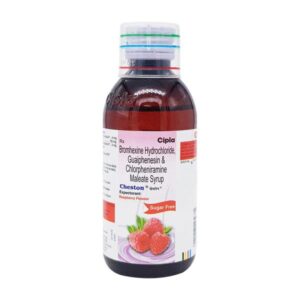CHLORPHENIRAMINE + BROMHEXINE + PSEUDOEPHEDINE
Chlorpheniramine: Chlorpheniramine is a medication that belongs to a class of drugs called antihistamines. It is primarily used to relieve symptoms of allergies, such as sneezing, itching, watery eyes, and runny nose. It can also be used to alleviate symptoms of the common cold, hay fever, and other respiratory allergies.
Chlorpheniramine works by blocking the effects of histamine, a substance produced by the body in response to an allergic reaction. Histamine is responsible for causing the inflammation and symptoms associated with allergies. By blocking the histamine receptors, chlorpheniramine helps reduce allergic symptoms.
The recommended dose of chlorpheniramine may vary depending on the individual, the severity of the symptoms, and the specific formulation of the medication. It is typically taken orally in tablet or liquid form. The usual adult dose is 4 mg every 4 to 6 hours, with a maximum daily dose of 24 mg. For children aged 6 to 12 years, the usual dose is 2 mg every 4 to 6 hours, with a maximum daily dose of 12 mg. However, it is important to follow the instructions of the healthcare provider or the package labeling for the correct dose.
Common side effects of chlorpheniramine include drowsiness, dizziness, dry mouth, blurred vision, constipation, and urinary retention. These side effects may be more prominent in elderly individuals. It is advised to avoid driving or operating machinery while taking this medication due to the potential for drowsiness or impaired coordination. Additionally, it is essential to avoid alcohol and other sedative medications as they can enhance the sedative effects of chlorpheniramine.
While chlorpheniramine is generally safe, it may not be suitable for everyone. Individuals with certain conditions like glaucoma, prostate problems, asthma, or urinary retention should use caution or avoid taking chlorpheniramine. It is always recommended to consult a healthcare professional before starting any new medication, especially if you have any existing medical conditions or are taking other medications.
Bromhexine: Bromhexine is a medication commonly used for the treatment of respiratory conditions associated with excessive mucus production, such as bronchitis and chronic obstructive pulmonary disease (COPD). It is classified as a mucolytic agent, meaning it helps to break down and thin mucus in the respiratory tract.
The main mechanism of action of Bromhexine is through the stimulation of the production and secretion of enzymes in the respiratory tract, which in turn helps to break down the viscosity of mucus and make it easier to cough up. This improves breathing and reduces the symptoms of cough and congestion.
Bromhexine is typically taken orally in the form of tablets or syrup. The recommended dosage may vary depending on the individual and the severity of the condition. It is important to follow the instructions provided by a healthcare professional or as indicated on the packaging.
As with any medication, Bromhexine may cause some side effects in certain individuals. Common side effects include gastrointestinal disturbances such as nausea, vomiting, and diarrhea. Some people may also experience headaches, dizziness, or skin rash as a result of using Bromhexine. It is important to consult a doctor if any side effects are severe or persist for a prolonged period.
In rare cases, Bromhexine can cause allergic reactions such as breathing difficulties, swelling of the face or throat, or hives. If any signs of an allergic reaction occur, immediate medical attention should be sought.
Overall, Bromhexine is a widely used mucolytic agent that helps to relieve respiratory symptoms associated with excess mucus production. It is important to use the medication as directed by a healthcare professional and to be aware of the potential side effects that may occur.
Pseudoephedine: Pseudoephedrine is a drug commonly used as a nasal decongestant to relieve symptoms caused by cold, allergies, and sinusitis. It is sold over-the-counter and can also be found in combination with other medications for cough and cold relief.
Pseudoephedrine works by constricting blood vessels in the nasal passages, which helps to reduce swelling and congestion. This action helps to alleviate symptoms such as a stuffy or runny nose, sneezing, and nasal congestion.
The typical recommended dose of pseudoephedrine for adults is 60 mg every 4 to 6 hours, with a maximum daily dose of 240 mg. For children between 6 to 12 years old, the dose is 30 mg every 4 to 6 hours, with a maximum daily dose of 120 mg. It should be noted that these doses may vary based on the specific brand or formulation of the medication, so it is important to carefully read and follow the instructions provided.
Common side effects of pseudoephedrine can include increased heart rate, elevated blood pressure, restlessness, nervousness, headache, dizziness, and insomnia. It may also cause dry mouth, increased thirst, and difficulty urinating. These side effects are usually mild and temporary, but if they persist or worsen, it is recommended to consult a healthcare professional.
Pseudoephedrine can also have potentially serious side effects, including allergic reactions such as rash, itching, swelling, severe dizziness, and trouble breathing. If any of these symptoms occur, immediate medical attention should be sought.
It is important to note that pseudoephedrine can interact with other medications, such as certain antidepressants, blood pressure medications, and other decongestants. Therefore, it is important to inform healthcare providers about all the medications being taken to avoid potential drug interactions.
Due to its potential use in the illicit production of methamphetamine, pseudoephedrine is regulated and sold behind the counter in many countries. In some regions, it may require a prescription or may have purchase restrictions to control its availability.


